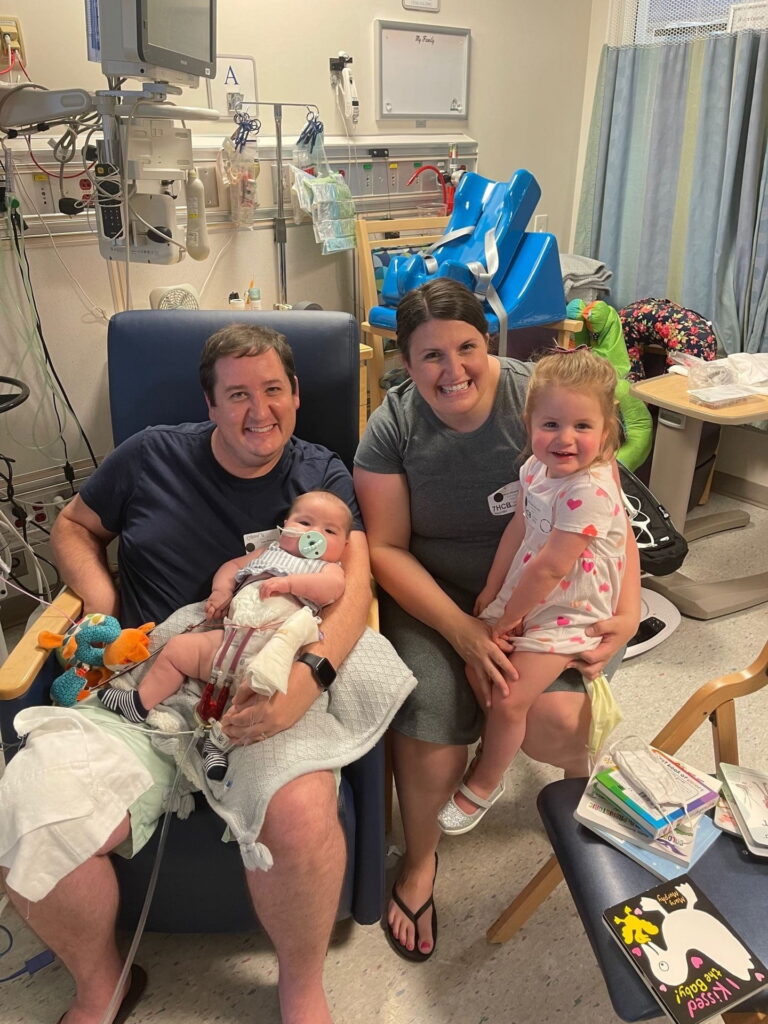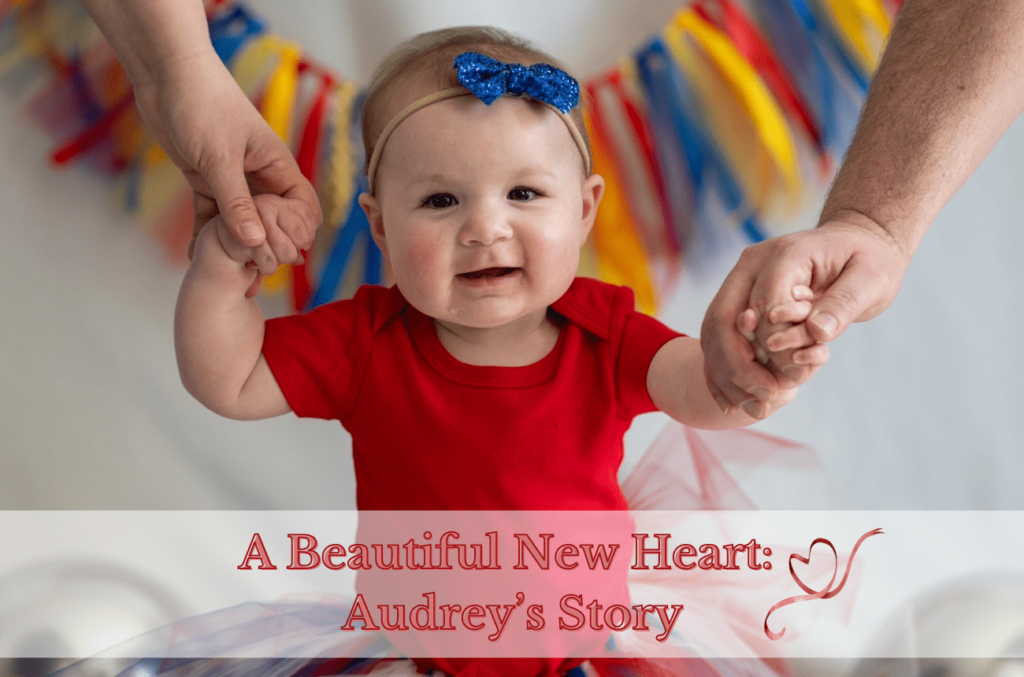This March, Audrey celebrated her first birthday at home with her family. Audrey loved her birthday cake and presents, but what her family loved most was having her at home. Audrey’s mother, Molly Wallach, knew there was a chance Audrey would spend her first birthday in a hospital room.
Audrey was born with a combination of rare heart conditions that required multiple operations, including a heart transplant at just six months old. Thanks to an organ donor and the team of specialists at the St. Louis Children’s and Washington University Heart Center, Audrey is a happy, healthy one-year-old girl.
“From the moment I learned of Audrey’s condition, I knew exactly what we were getting into,” says Wallach, who is an assistant nurse manager at the Heart Center. “For over a decade, I have dedicated my career to helping babies and kids with congenital heart defects, but I never thought I would have a child who would need surgery.”
In her first year, Audrey needed two major operations. The first implanted a device to support her heart function. The second gave her a new heart.
Rising to the Occasion
Before she was born, Audrey was diagnosed with a congenital left ventricular aneurysm.
The left ventricle is the chamber of the heart that pumps blood to the body. In a healthy heart, the muscle in the left ventricle is thick and strong. A left ventricular aneurysm is a rare condition that happens when the muscle in this part of the heart is stretched thin. This can cause problems with the way the heart functions, including heart murmurs, arrhythmia, and even heart failure or stroke.
Three weeks after Audrey was born, she was diagnosed with another condition affecting the way her heart pumped blood, called dilated cardiomyopathy. The combination of left ventricular aneurysm and dilated cardiomyopathy caused Audrey to have signs of heart failure a few weeks later. Thankfully, her mother knew exactly what to do and rushed Audrey to St. Louis Children’s Hospital. It was clear that she would need surgery.
Audrey’s Heart Center team included Pirooz Eghtesady, MD, PhD, Cardiothoracic Surgeon-in-Chief at St. Louis Children’s Hospital, as well as Washington University congenital cardiac surgeons Jacob Miller, MD, and Dilip Nath, MD.
“Molly and Sam are incredibly doting and caring parents. They rarely left the bedside,” says Dr. Eghtesady. “Undoubtedly, as the saying goes, ignorance is bliss, but this was far from bliss for Molly who had so much knowledge about cardiac diseases, having worked for many years taking care of other families and kiddos with heart conditions. I’m certain this insight, knowing there is always an associated risk and potential for complications, made it even harder for them as a family. But they rose to the occasion with grace, showing tremendous resilience.”

Keeping Hearts Pumping
A ventricular assist device (VAD) is a type of mechanical device that helps the heart pump. For people who need heart transplantation, a VAD can serve as a bridge therapy until a donor heart becomes available. Audrey’s first surgery was a procedure to implant a VAD when she was three months old.
The Heart Center is a nationally recognized Mechanical Assist Device program, meaning patients and their families have access to national leaders in VAD support. Placing a VAD in a left ventricular aneurysm is an exceptionally rare procedure, but Wallach knew her child was in good hands with Dr. Eghtesady, who is also chief of pediatric cardiothoracic surgery at Washington University.
“Dr. Eghtesady has such a calm confidence,” Wallach says. “I remember him coming up to me on the night of Audrey’s first surgery, putting his hand on my shoulder and saying, ‘I’m going to take care of your daughter.’ I was so scared, but then I felt this rush of relief. I knew that Dr. Eghtesady would go to the ends of the earth for Audrey.”
Audrey’s VAD placement was a success. Audrey could take bottles, play on the floor, go out in the garden and do everything the Wallachs wanted their baby to be able to do. VAD was not a permanent solution, but it kept Audrey healthy until a new heart became available.
“As a practitioner, it was anxiety provoking that I was caring for one of our own, someone you work with on a day-to-day basis, many times managing those complications for other families,” says Dr. Eghtesady. “At the same time, the trust and privilege they provided us by trusting Audrey’s care in our hands was a testament to the relationship as well as a precious vote of confidence in our team. In the end, what comes to my mind is the word gratitude: I am grateful they would trust Audrey’s surgery to us and that we were able to provide her with a great outcome.”
Now that Audrey has a beautiful new heart beating in her chest, we’re going to let her live a normal life.
Molly Wallach
Cheering for Audrey
There are about 100,000 people in the United States waiting for an organ transplant, including 4,000 adults and children waiting for a new heart. For some, the wait can be months or years. A single organ donor, according to Washington University transplant specialists, can save as many as seven lives.
“Pediatric heart transplants are often challenging due to the unique anatomy each patient brings with them. Additionally, often times they have undergone many operations prior to requiring a transplant,” says Dr. Miller. “Fortunately, in this case, the anatomy was normal and her only prior operation was the VAD implant. In children, sometimes it can take some time to get an appropriately sized organ.”
In total, Audrey was waitlisted for a transplant for just over three months. She spent this entire time in the hospital, supported by her VAD and the love of her family.
“Due to the anticipated time she would spend on the wait-list, we pursued a VAD to keep Audrey well supported until a suitable donor arrived,” Dr. Miller says. He notes that a VAD implant is a cardiac operation, so there is always some risk involved. “While supporting someone with a VAD has progressed substantially, it is still not without risk. Every day while supported with a VAD is another day of risk. That is one of the reasons every organ donor is so important.”
Having a team of experts in your corner is essential when your child needs a new heart. The heart transplant program at St. Louis Children’s Hospital was established in 1986. In 2019, the program became the first pediatric program in the Midwest to reach the milestone of 500 heart transplants. The heart transplant care team is there for the family every step of the way, from emotional support and financial planning to transplant coordination and lifelong postoperative follow-ups. The team even provides text updates during surgery so that parents and families have up-to-the-minute information on their child. Wallach says she felt like had the best support possible for her family during this scary time.



“For more than 35 years, St. Louis Children’s Hospital has been at the forefront of heart transplantation ranging from neonates to adult congenital patients,” says Dr. Nath, who performed Audrey’s transplant alongside Dr. Miller.
When a child leaves the Heart Center after a long hospital stay, they get a very special farewell. Everyone on the team lined up in the halls to cheer for Audrey and her family. In her ten-plus years in the Heart Center, Wallach had been part of countless discharge celebrations, but this time was extra special. This time, it was her own daughter finally leaving the hospital after a long stay and two major operations.
“We walked out and everyone was cheering us on,” Wallach says. “The magnitude of that moment was amazing. We finally made it to this day, and Audrey’s coming home with us. It’s hard to describe the overwhelming sense of gratitude we have.”
A Chance at Life
“We were able to celebrate Christmas with Audrey at home,” Wallach says. “We wouldn’t have been able to do that without somebody saying yes to organ donation. We are so grateful that another family wanted to give somebody a chance at life.”
Now that Audrey is back home with her family and a new heart, the Wallachs want to give her a normal childhood. Audrey had an unusual first year, but now she looks and acts like a healthy one-year-old girl. Wallach says Audrey is smart and stubborn. She loves to play with her big sister, Caroline, who Wallach says is very protective.
“Our goal is to give her the same childhood that we’re giving Caroline,” Wallach says. “We want Audrey to experience life. I don’t want to hold her back, because I know she won’t hold herself back. Drs. Eghtesady, Miller and Nath always remind me that, at the Heart Center, we choose transplant because we want kids to live. Now that Audrey has a beautiful new heart beating in her chest, we’re going to let her live a normal life.”
